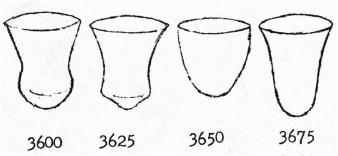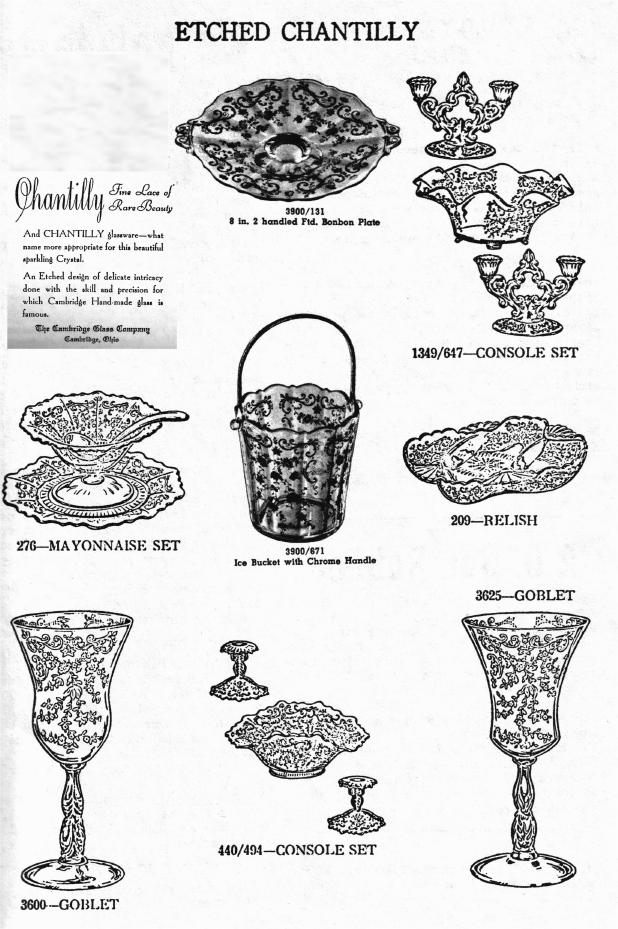Etchings - CHANTILLY
by Phyllis Smith
Issue No. 71 - March 1979
Corresponding with our many members happens to be one of the more rewarding sidelights of being Editor of this publication. The gratification derived is two-fold in as much as it allows me to become better acquainted with each of you and it also affords me the opportunity of furthering my knowledge of Cambridge Glass at the same time.
A case in point is the following letter from one of our newer members.
"Dear Phyllis, Last summer I became interested in Depression Glass. After subscribing to several of their publications I began reading about Cambridge Glass. It rang a bell.
Twenty-seven years ago as a Wedding present, I received eight Chantilly glasses. I never used them much because they were so pretty. Anyway, I still have seven.
So, I promptly joined N.C.C.. Inc., bought both books put out by N.C.C., Inc., and Bennett's book. I've really been studying my books and my issues of the CRYSTAL BALL. My problem is this -- I'm confused -- I don't know the difference between the 3600 Line and 3625. In my book ('49-'53) page 58, the glasses I have look like 3625 12 oz. footed Ice Tea. The glasses are 7-3/4" tall, the stem is two inches high, they hold 12 oz. right even to the brim, and they are 6-1/4" around the smallest part. I want desperately to correctly identify them as I wish to add to them.
Another question -- I never see much Chantilly advertised for sale. Was this not produced very long? Do you think it too scarce to try to find? Any information you can give me will be appreciated.
Thank you very much -- Sincerely, Jerry Strange, Kentucky."
Being confused when it comes to identifying Cambridge stem lines is not new! In fact it is probable that we all suffer with this problem from time to time. But, do not despair Jerry (and others), there is an answer to all our confusion and it can summed up in just one word - STUDY!
As you can see by the reproduction of the Patent application as shown here, this lovely stem line had its beginning way back in 1938. This original patent was for the STEM only. The bowl shown on this stem is the original #3600 line bowl. At a later time this line was enlarged to include different shaped bowls on this same stem and they in turn were numbered #3625, #3650 and #3675.
The main thing to remember is that all of these lines are on the same stem - only the shape of the bowl is responsible for the various line numbers.
It is an admitted fact that every bit of study information we have available to us at this time only adds to our confusion. The photos and art work in all of the catalogs we have available use black background and therefore reproduce very poorly, making identification extremely difficult.
 We have
made the line drawings shown here in the hope that they will more
clearly show the differences in the shape of the four bowls.
We have
made the line drawings shown here in the hope that they will more
clearly show the differences in the shape of the four bowls.
It is hoped that acquainting you with the fact that there are four different bowls available on this stem, rather than just two, will help and not further confuse you in your quest for identification of your particular stem line.
In answer to your question concerning the availability of the Chantilly pattern. Let us immediately put your mind at ease by telling you that this beautiful etching was produced by the Cambridge Glass Company for many years, beginning shortly before 1940 and continuing until the plant closed its doors for the final time in 1958. It could have been produced in just about everything that the company manufactured during those years, but it is shown primarily on the #3900 Line dinnerware and serving pieces.
Why it is not advertised for sale more extensively at this time can probably be attributed to lack of demand. Rosepoint etching seems to be the most popular among collectors at this time, hence it is more widely advertised.
In the April, 1977 issue of the CRYSTAL BALL, we featured one of our members in an article concerning her collection of Chantilly etched ware. In a period of two and a half years, she had managed to collect over 100 pieces of this beautiful pattern. This surely proves that it is not "too scarce" to try to collect.
Thank you for writing and affording us the opportunity of furthering our never-ending study of our favorite glass -- CAMBRIDGE!

